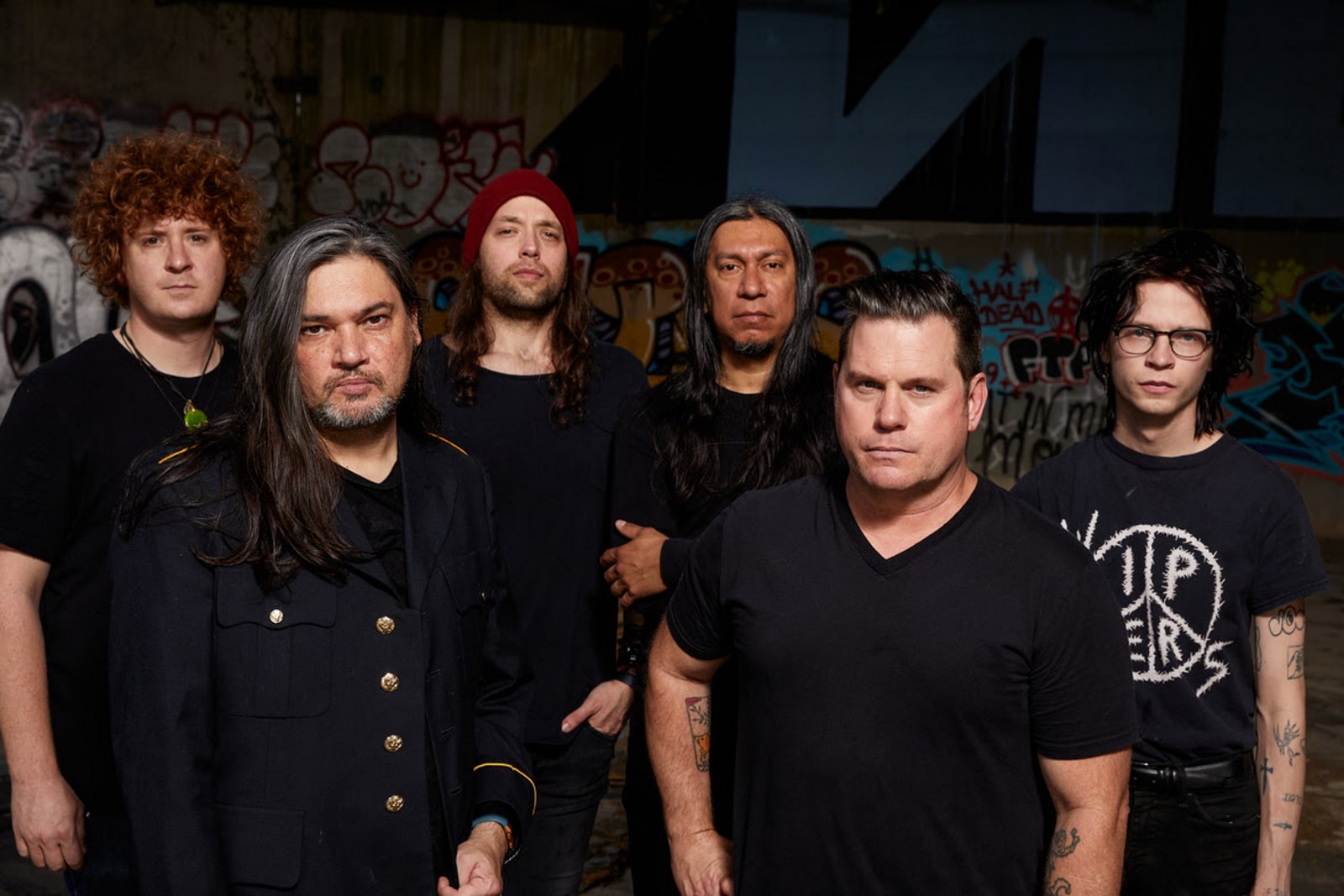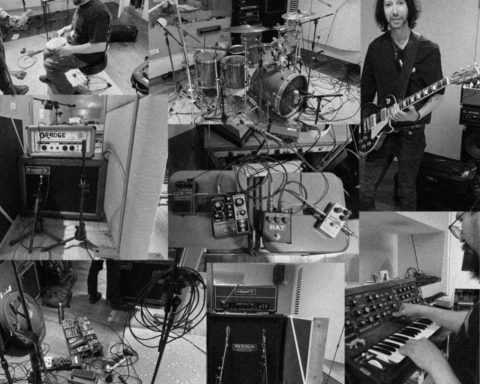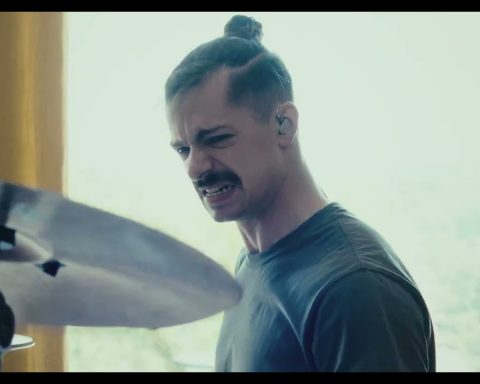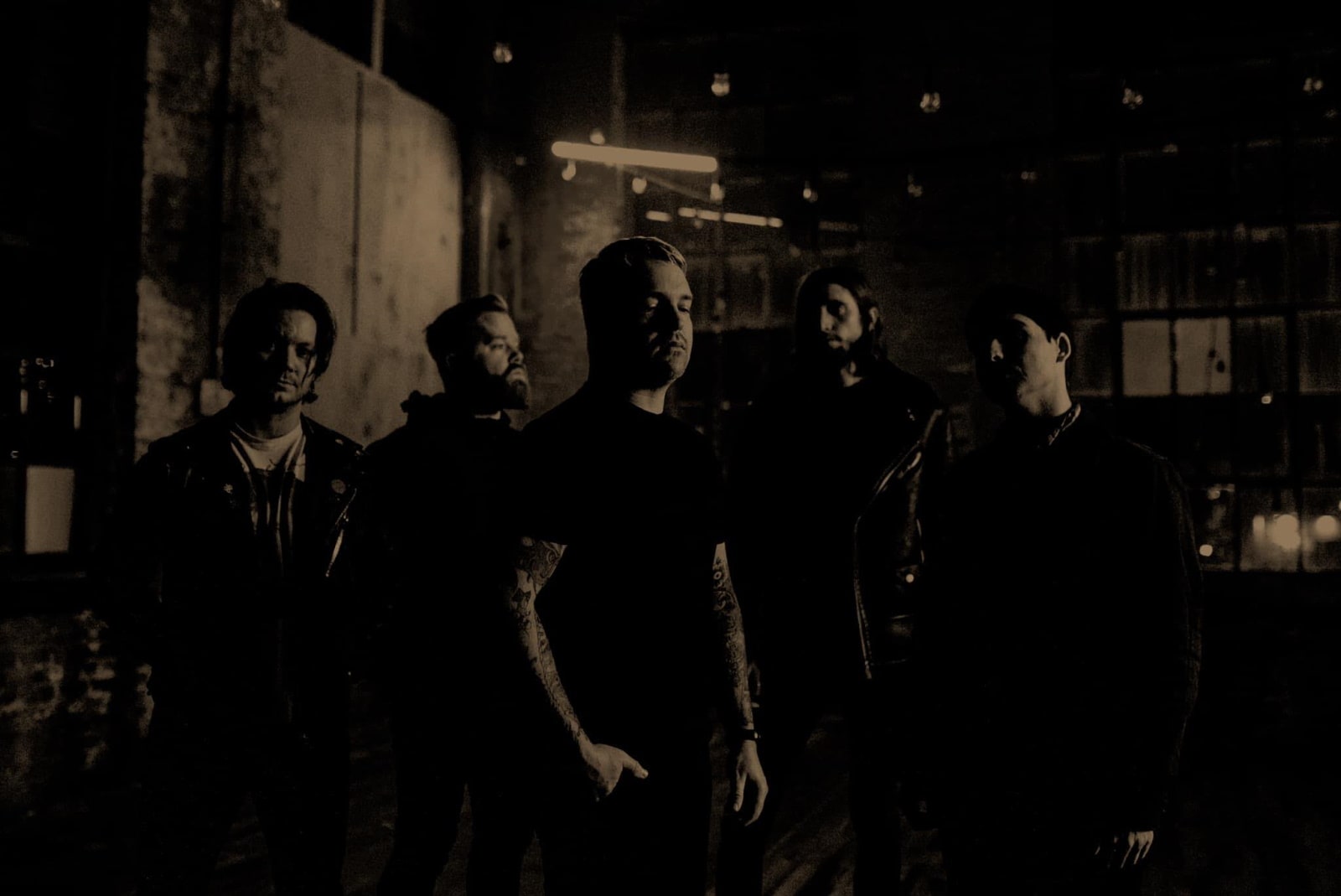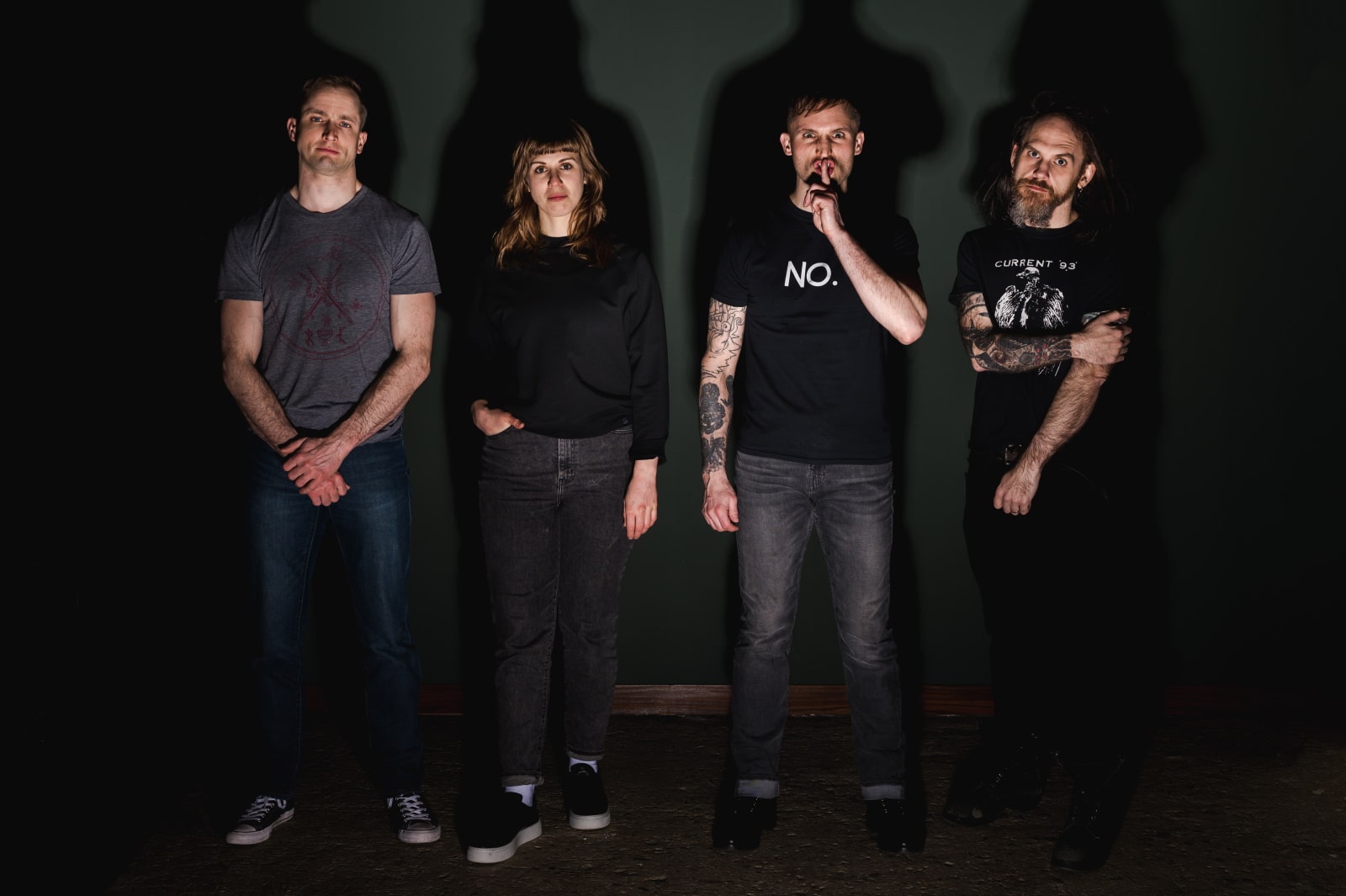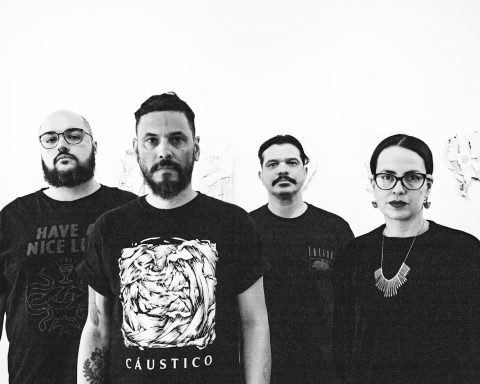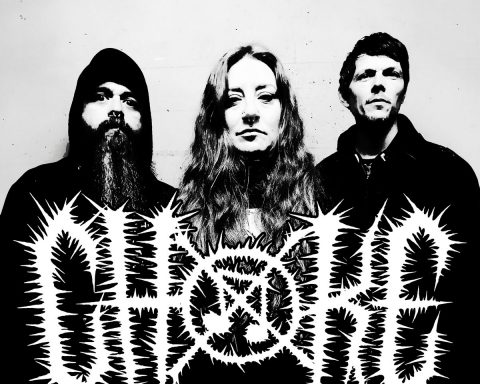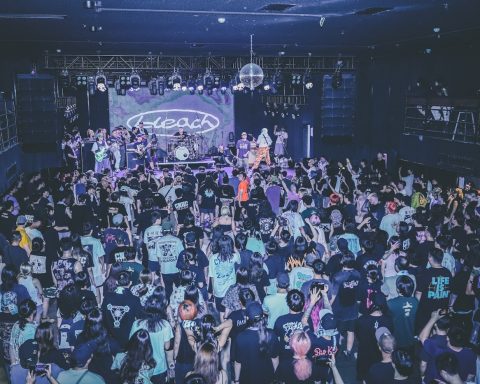Austin’s own …And You Will Know Us by the Trail of Dead have premiered the music videos for “Penny Candle” and “Contra Mundum” off their forthcoming full-length studio album – XI: BLEED HERE NOW – due out July 15, 2022 via Dine Alone Records in North America. The double video release also coincides with the on sale of their August US headline tour – get tickets HERE.
XI: BLEED HERE NOW is the 11th full length album from the band and their first in quadraphonic sound. For more insight on the new LP, read the album bio written by Trail’s own Conrad Keely HERE, preorder and pre-save the July 15th release HERE and confirmed dates are below.
Read BLEED HERE NOW bio by Conrad Keely below.
XI: BLEED HERE NOW is due out July 15 via Dine Alone Records and was produced by Trail’s own Conrad Keely and Jason Reece alongside Charles Godfrey. It was mastered by Scott Sedillo and KamranV at Bernie Grundman Mastering and is QUARK encoded to play in both stereo and Regular Matrix quadraphonic sound.
…And You Will Know Us by the Trail of Dead Confirmed US Tour Dates
8/9 @ Scout Bar in Houston, TX
8/10 @ Alabama Music Box in Mobile, AL
8/11 @ Masquerade in Atlanta, GA
8/12 @ The East Room in Nashville, TN
8/13 @ Hi-Tone in Memphis, TN
8/14 @ 89th St OKC in Oklahoma City, OK
8/16 @ Hi-Dive in Denver, CO
8/17 @ InsideOut in Albuquerque, NM
8/19 @ Psycho Fest in Las Vegas, NV
…And You Will Know Us by the Trail of Dead Confirmed EU Headline Dates
9/27 @ Petit Bain in Paris, FR
9/28 @ The Dome in London, GB
9/29 @ Effenarr in Einhoven, NL
9/20 @ Rotown in Rotterdam, NL
10/1 @ Gebaude 9 in Cologne, DE
10/2 @ Café Glocksee in Hannover, DE
10/3 @ Forum in Bielefeld, DE
10/4 @ Kent Club in Hamburg, DE
10/6 @ Radar in Aarhus, DK
10/7 @ John Dee in Oslo, NO
10/8 @ Mejeriet in Lund, SW
10/10 @ Festsaal in Berlin, DE
10/11 @ Hybrydy in Warsaw, PL
10/12 @ Underdogs in Prague, CZ
10/13 @ Alte Malzerei in Regensburg, DE
10/14 @ Strom in Munich, DE
10/15 @ Franz K in Reutlingen, DE
10/16 @ Flex in Vienna, AT
10/17 @ Substage in Karlsruhe, DE
10/18 @ Sommercasino in Basel, CH
10/19 @ Locomotiv in Bologna, IT
10/21 @ Razzmatazz 3 in Barcelona, ES
10/22 @ Nazca in Madrid, ES
TRAIL OF DEAD XI: BLEED HERE NOW, by Conrad Keely
I was raised by a pair of New Age hippies. Not actual hippies, but the later generation of truth seekers who were too young to have actually attended Woodstock or partied during the Summer of Love. More like early incarnations of the free-spirited travel-loving folks who would eventually be referred to as “backpackers”.
There was always a copy of Ram Dass’s Be Here Now on the coffee table in the living room. Not just our living room table, but that of every pseudo-hippy friends’ house we’d visit. It was ubiquitous. As a child, the brown-colored portion of the book with hand-drawn illustrations of naked yogis looked like something promising I might be entertained by, but upon closer inspection revealed itself to be way too “far out” even for an artistically-inclined kid like me.
It wasn’t until recently I learned the chair in the center of the mandala on the cover was meant to represent Vincent van Gogh’s chair from his famous painting “The Bedroom”, of his actual starving-artist cliché bedroom in Arles. It was meant to symbolize the Seat of Consciousness. Our true consciousness––that which abideth within this crude machination of clay and feldspar.
January 2020 started as typically as any other album release date. We had a spring and summertime’s worth of touring and festivals booked, we were modestly happy with what we’d recorded (as self-critical as we tend to be); and better yet, we’d put together a new five-piece live lineup that rivaled anything from our past and was only getting better with each show. By the time we got back from our February/ March 2020 European/UK tour we were confident, we were cocky––we were kicking ass! It was only once the initial shock and horror of a year’s worth of pandemic-necessitated cancellations had sunken in––and we’d processed the fact that the band had absolutely nothing to do––did I wake up one day with a sudden, overwhelming sense of peace, serenity, and centeredness. Like Ron Livingston in Office Space––waking up from his euneirophrenic hypnosis session and suddenly seeing the world anew. We literally had nothing to do! Just like what Ram Dass had described in Be Here Now. This was amazing! Put simply, it was a dream come true.
It took several bliss-filled, perambulating months of hiking the hills surrounding Austin, walking dogs, cooking at home and reading books (actually reading books again!) that I started to think, hmmmm… maybe we should start a new album. I mean, why not, right? There were some really great music documentaries coming out at the time, which had inspired in me a sense of reconnecting with that oftnostalgized (that’s not actually a word btw) Golden Age of rock music. You know the one: back before Autotune (pronounced with a German accent, for some reason), before Pro Tools, before these stultifying, mind-numbing levels of compression had made sound files look like perfect Lego blocks instead of rising and falling tides of atmospheric evolution.
It was that bygone analog era that we wanted to reconnect with. But it was this newfound digital era that we wanted to describe. What sort of times were we actually living in? Weird and unfamiliar seemed almost understatements. It was as if nothing short of an alien invasion could actually surprise anyone, anymore. One could almost imagine the bemused and ironic joke-meme responses that first contact might elicit on TikTok, rather than the blood-curdling screams that men landing from outer space would have garnered in the 1950s.
Because of all this time on our hands, and absolutely no pressure from absolutely nobody, we had the untrammeled luxury of starting off very, very slowly. Instead of getting together for rehearsals in some musty, sound-proofed garage, starting in February of 2021 we met at my house. And we just talked.
No tours to look forward to, no shows lined up. Just plenty of time and latitude to sit and talk. We talked about music documentaries, pulled up YouTube videos of performances we loved and cherished, traded hearsay stories of our musical influences, biography recommendations, discursive ramblings on music theory, popular culture, recreational drug use, and the ontological absurdity of genre classifications. Why is the ridiculously self-indulgent story of Mötley Crüe (The Dirt) every bit as poignant and entertaining as the ridiculously morbid story of Mayhem and the Norwegian Black Metal movement (Lords of Chaos)? We compared what we loved most about rock and roll, down to its essence––the very noumena. After all these lean years (where we’d grown fat) and less-than-glorious album sales (had that last album even sold any copies after we stopped touring?), what was it that made us still want to make albums and not go into real estate, cryptocurrency, or professional gambling?
And yes, we even felt obliged to pull up more recent albums, and kept asking ourselves the same question: why do all these new albums sound so… dare we say it, bad? What happened to music production? I mean, many of these records had huge budgets, and yet they opted for etiolated mixes that seemed to say more about digital technology than they did anything else. Such as the things we’d been raised to cherish about our favorite albums: authenticity, humanity, revolution. We had probably less than one-tenth of a major label budget to make an album. How could we record something that would live up to our expectations? How do we Moneyball this album––in other words, how do we make it sound like it was made for a million dollars, when in actuality all we really had was an independent record budget that was almost guaranteed to have nothing left over at the end?
We came up with a basic plan, based on VH1’s Behind The Music and Classic Albums documentaries of the albums we loved––Led Zeppelin, Rush, Peter Gabriel, Kate Bush, Fleetwood Mac, Pink Floyd. We would do it like a lot of them had done before. Instead of paying hourly rates at some hip, high-tech professional studio, we would find a spot we could afford to lease for a couple months so that we never felt stressed for time, and in a relaxing location that would put us at complete ease and make us look forward to showing up every day.
We had just the spot. Some friends of ours had their rehearsal space in a large, old-style Texas barn on their property, adjacent to a huge field. Texas hippy bands used to rehearse there back in the seventies. Horse thieves had probably tried to steal horses from it back in the 1800s; the Indian Wars had been waged in the field outside; the Clovis people had flint-knapped and skinned mastodons down by the creek; and Santa Anna quite likely marched his troops across the property on his way to the Alamo (not really on that last one since they’d marched northwards from San Luis Potosi, but one could always imagine).
The tracking room was large enough to keep two drum kits permanently set up and mic’d. Two kits, like we used to do. Three guitar stations also set up (we didn’t know who’d be playing what on each song, it was musical chairs). A.J. had the only permanent station––his Wall of Synth, next to his Leslie cabinet. That was going to be a big feature on the album; the classic rock sound of a dirty organ, the Leslie vibrating its harmonious distortions through the wooden floors of the barn.
Our producer Charles Godfrey, was he happy about it? Hell no, he wasn’t. There was a low frequency hum emanating from below the floorboards (that only he could hear, I insisted jokingly), it would fuck with the monitoring system. That’s fine, I shot back. There’s a soccer pitch, an archery target, and a grill area outside. When things get frustrating, we’ll just go outside, light a cooking fire, kick the soccer ball, throw the frisbee around, then go back in and record some more.
We invented a sport. It’s called “Frizball”. It involves players throwing a frisbee and kicking a soccer ball at the same time.
On my birthday in May I got a pocket-dial from an old friend from Interscope Records, Kamran. Or did I pocket-dial him? We never did work out which. Back then he was head of the label’s “New Media” department (this was before anyone had coined the term “social media”). Either way, we were soon deep in catch-up: he’d been working on Moog Fest until Covid had caused that to grind to a halt. I’d been collecting synthesizers, I told him. I loved all the new Behringer clones we’re using on the album: the Poly D, the Mono/Poly, the ARP 2600, the VC340 Vocoder (heard very loudly on the track Golden Sail).
That conversation led him to bring up the synthesizer-pioneering legend Suzanne Ciani. Of course I’d heard of her! I loved her Buchla Concerts 1975 album. “Yeah we just produced her new album,” Kamran told me, “it’s called LIVE Quadraphonic. It’s actually in quadraphonic. You guys should do a quadraphonic album… I can tell you how, it’s way easier than you think!”
I wish I’d recorded that conversation, actually. Because by the next day, that’s what we all agreed we were now working on. Without actually knowing yet how we were going to do it, of course. But it made perfect sense––we had two drum kits set up. And with three guitars going, and the keyboards, and the new harmony parts we were trying out––why not do it in surround? Sure, there hadn’t been a rock album recorded in quad since the seventies, and we’d have to sell the idea to the label. Would it play on vinyl? Even if it did, none of us had a quad system to listen to it on at home. But…
But, Kamran assured us this was going to be a lot easier that we thought; because of a software plugin called Quark that he’d received a grant from the National Endowment of the Arts to develop. It painlessly “folded” a surround mix down to stereo for quick reference. Not only that, but surround sound was far more accessible than most people realized. Most of our computers, entertainment systems, and even streaming services are already set up for it. We just don’t usually make the technological leap, or we regard it as existing in the realm of the “audiophile” or sound system aficionado. It was like a scene from Walk Hard, where the caveats being expressed were clearly not meant to dissuade anyone: “You don’t want none of this shit, Dewey! It turns all your bad feelings into good feelings”.
For those who aren’t recording engineers, it’s important to note the difference: you don’t record an album in surround. You just record like you’ve always recorded. You mix the album in surround. However, if you have the intention of mixing in surround to begin with, you suddenly find yourself making slightly broader decisions when approaching the recording. For instance, tracking our friends in the Tosca String Quartet for the live string arrangements on the opening theme Our Epic Attempts and the Bridgerton-esque (as we jokingly called it) string performance on Millennium Actress, we set up the mics with the idea that we could mix them into four channels rather than two. When doing the vocals for Growing Divide, we thought how cool it would be to have our friend Britt Daniel come in to sing one of the harmonies, so that we could have four different voices separated out between two stereo mixes. And although our old friend Amanda Palmer was now living in New Zealand (the only artist on the album who was not recorded here in Austin, Texas), wouldn’t a male-female vocal duet with her sound amazing, separated front and back?
It was only after two solid months of recording, playing Frizball, cooking barbecues outside (the “someone check the potatoes!” reference at the end of Salt In Your Eyes was quite literally us reminding each other that there were potatoes on the grill outside that needed checking), honing our archery skills, and having some very memorable wine-fueled get-togethers with friends to come listen to what we’d been working on, was it finally time to move the album into Charles Godfrey’s mixing studio and hear for the first time what this ponderous, excessive-of-sixty-minutes experiment was going to sound like when separated out between four speakers and into two separate stereo mixes.
By emphasizing the play involved in making this album, my intention is certainly not to downplay the work that went into it. Merely that playing hard allowed us to tackle our work with newfound fervor and enthusiasm. As always there is a self-reflection we have continued to develop in our lyrics, and this continues to be tempered and informed by what we see going on around us in the world. Perhaps now more than ever there is a sense that the time for frivolity and mindless decadence has passed, and collectively we are moving into a time when music can’t afford to simply distract us into excess, indulgence, and an insouciant indifference to world events. Art has a role to play in the upcoming decade(s): it needs to point humanity towards solutions. Our hope is that by expanding the ways we listen and hear, we expand our own inner (my parents would say spiritual) potential for the problemsolving to come.
Our conclusion? Modern music doesn’t have to be (and never should have been) compartmentalized or dumbed down and forced to conform to a genre in order to be appreciated by music appreciators. In our thirst for convenience we’ve created a streaming monster that tells us what to listen to and how to think about what we hear. This contributes not only to our own primate predilection for settling for the lowest hanging fruit, but also to the general borborygmus we allow ourselves to be entertained by when not actively listening. These artificial intelligences that choose the next song on the playlist for us, and subsequently tilt the balance towards the insipid, do us a great disservice by contributing to our own mental laziness and musical confirmation bias. Worse still, is that we allow them to.
We’re not trying to make genre music here. We’re trying to make good music. We’re willing to bleed for our efforts. Listen; tell us how you think we did.



